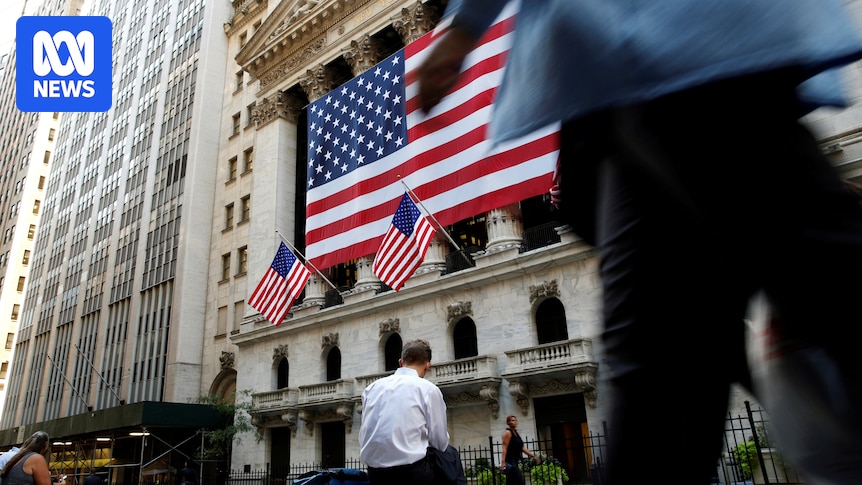Australia’s big insurance companies were sold off heavily on the share market on Friday.
Analysts readjusted their valuations after a wave of anxiety hit the sector on Wall Street on Thursday.
The central concern for investors is that growth in insurance premiums (a major source of revenue for insurance companies) is slowing significantly.
The Wall Street sell-off began when Goldman Sachs, Morgan Stanley, JPMorgan, and Bank of America all downgraded their revenue forecasts for the US insurance sector.
They cited “decelerating net written premiums (NWP) growth” from the high single-digit rates in 2023-2024, to mid single-digits (3-5 per cent) in 2025.
Analysts say US insurance companies have leaned heavily on rising inflation as a reason to lift insurance premiums in recent years.
Now inflation is largely under control, that reason is no longer valid.
Wall Street reached another record high on positive economic data and company profit results. (AP: Richard Drew, File)
This, says Wilson Asset Management, could see lower growth in insurance premiums for insurance companies across the globe.
“Analysts don’t see too much growth in US premiums anymore,” the ABC was told on a call with the investment firm.
“Australian insurers are being hit by that idea.
“QBE’s share price has suffered the most damage because it has the biggest US exposure.”
A canary in the coal mine
The ABC also understands stockbrokers are keenly watching US-based The Travelers Companies.
It is a US multinational insurance company.
Consumers in dark over insurance premium hikes
It fell 4.6 per cent Friday (Australian time) after reporting “net premiums” below what the market was expecting.
It appears to be further endorsement that the premium cycle may have peaked.
The premium cycle refers to the cyclical ups and down in insurance premium growth.
US regional banking exposure
There are also concerns around the exposure Australian insurance companies may have to US regional banks.
Zions Bancorporation, Jefferies, and Western Alliance fell sharply on Friday (Australian time) as investors grew uneasy about risk in the sector.
These banks had exposure to two auto bankruptcies.
Zions disclosed it would take a $50 million loss in the third quarter on two commercial and industrial loans from its California division.
Western Alliance separately disclosed it had initiated a lawsuit alleging fraud by Cantor Group.
The ABC has been told that stockbrokers think the sell-off in Australian insurance companies was compounded by credit risk in US regional banks.
The ABC understands that queries from clients of stockbrokers are mostly around QBE investment risk, not premium rates.
QBE told the ABC it had no comment.
Bond markets hurting insurers
The bond market is also playing a role in the so-called “risk off” sentiment in the insurance sector.
Insurance companies invest in bonds, and the bond market has been volatile this year.
Anthony Albanese says insurers are ‘ripping off’ Australians
“IAG’s [results] earlier this year tempered growth expectations, but [growth is] now down amid falling yields,” investment manager Roger Montgomery said.
“[Suncorp is also down] on [bond] yield sensitivity and in sympathy with financials and insurers being the weakest sector in US overnight.
“And [there are] a bunch of the usual culprits: softening demand in property and casualty, heightened competition, regulatory scrutiny, and economic headwinds (inflation and rising claims costs),” he said.
Mr Montgomery also raised “contagion risks” to insurers via reinsurance and lending ties to potentially distressed regional US banks.
Lower premiums could mean lower interest rates
While concerns over potential revenue streams for global insurers is worrying investors, it is potentially good news for Australian households and motorists.
Annual services inflation continued to ease for most categories in recent quarters.
Australia’s unemployment rate jumps to 4.5pc
In the June quarter, there was a notable drop in price rises for insurance, from 14 per cent increases last year to less than 4 per cent in the 12 months to the June 2025 quarter, according to ABS data.
A further drop in insurance premium growth could see this segment of the inflation basket contribute less to overall inflation.
Insurance prices contribute roughly 1.4 per cent to the overall basket of goods and services measured by the ABS for its inflation calculations.
Any material reduction in underlying inflation would bolster the case for further Reserve Bank interest rate cuts, especially if it comes from the services sector.
The Reserve Bank has repeatedly said inflation in the sector has proven particularly sticky.
Analysts certainly see that potentially loosening up now.

